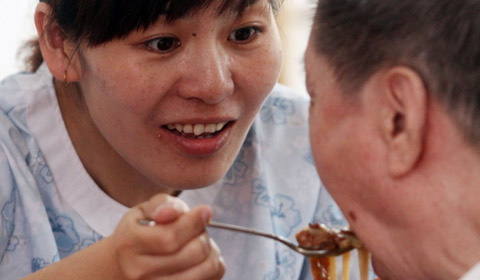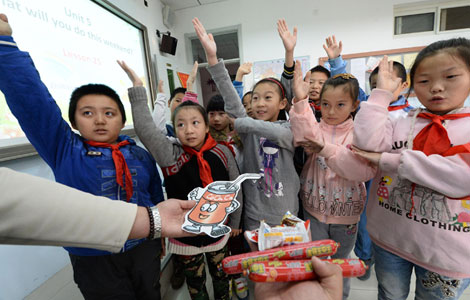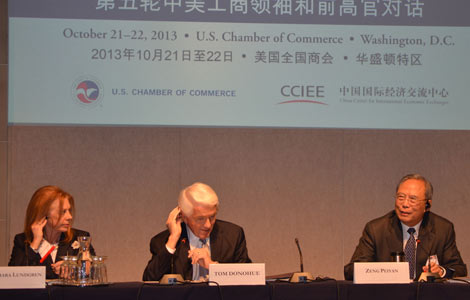Shanghai boosts education services
Updated: 2013-10-24 08:12
By Wang Hongyi in Shanghai (China Daily)
|
||||||||
"Schools in Britain, Australia and Canada are all in our vision, but we pay more attention to their quality and performance, which may help drive the improvement of Shanghai's education level."
Last year, Shanghai New York University was founded as China's first China-US university as an independent legal entity, operated by New York University and Shanghai's East China Normal University.
Its model of education and international courses has drawn attention from Chinese students and education experts. This year, about 500 Chinese students took part in the first round of admission interviews, with 151 eventually accepted.
The city is also encouraging universities to carry out more high-caliber programs with overseas institutes.
In 2006, Shanghai Jiao Tong University and the University of Michigan announced a joint venture to cultivate mechanical engineering expertise. It is one of the first international higher education institutes in China modeled after top US research universities in terms of academic environment, faculty quality, research opportunities and educational program guidelines.
The course systems were based on the University of Michigan system, joint bilingual teaching by Chinese and foreign teachers, mutual recognition of academic credits, and an innovative education system adapted to the global environment and its graduates.
The cooperative program has proved to be a great success and has also been recognized as an innovative model of China-US collaborative education for training world-class talent.
"The cooperation program was a successful example of promoting China's higher education development and talents' training," education official Yang said.
Hua Ouyang is a professor at Shanghai Jiao Tong University's School of Mechanical Engineering and taught in a cooperative program between the university and the US' Purdue University.
"The joint-teaching mode is beneficial; different culture, different thinking modes," he said, adding that combined education methods help both foreign and Chinese students learn more from each other.
Education goal
The next step for the city's education authorities, according to Yang, is to establish a cooperative vocational school. The education commission is looking for qualified international bodies for cooperation, he said.
Shanghai has more than 220 China-overseas cooperative education bodies and programs. It plans to add another 40 by 2015.
"We don't want to expand quickly. Our goal is to create fine education," Yang said.
The number of international students in the city has been rising. Last year, about 51,000 overseas students were studying in Shanghai, most from South Korea, Japan and the US.
City authorities hope that number will increase to 70,000, about 40 percent, by 2015.
In recent years, the city has announced a series of favorable policies and scholarships to encourage more outstanding foreign students to study at its universities.
Shanghai has been offering scholarships to international students since 2005, and more than 25 million yuan ($4 million) is granted to students each year, Yang said.
According to a Shanghai Education Commission development plan, the city will establish a comprehensive scholarship system to attract outstanding students. "Only a third of foreign students in Shanghai are in long-term degree programs," Yang explained. "We hope more outstanding foreign students can study for longer education programs, which last more than half a year."
This year, the commission set up a website - study-shanghai.org - in Chinese, English, Japanese and Korean for international students to apply for government scholarships.
The website also provides information about summer school courses, open classes, lectures and international exchange programs, as well as information about the city.
"Living in Shanghai is very easy for foreigners because of how developed and well-planned the city is," said Derek Tan, an international exchange student from Purdue University.
He finished his spring semester at Shanghai Jiao Tong University's School of Mechanical Engineering in May.
"There are many small differences between Chinese and American culture. There aren't any glaring differences that make life difficult - the difficulty comes from the combination of small differences," Tan said. "These are not things that can be taught in the classroom and are part of what makes the experience in China such a good one."
wanghongyi@chinadaily.com.cn

 Mass. teacher slain; 14-year-old student charged
Mass. teacher slain; 14-year-old student charged
 Driven by smiles
Driven by smiles
 Camp gives sporting chance for students headed overseas
Camp gives sporting chance for students headed overseas
 Chinese protest UK 'fishing' raids
Chinese protest UK 'fishing' raids
 Caretakers in need of counseling
Caretakers in need of counseling Pumpkin fun ahead of Halloween
Pumpkin fun ahead of Halloween
 Weakening Raymond soaks Mexico, no serious damage
Weakening Raymond soaks Mexico, no serious damage Apple unveils new Macs, iPad ahead of holidays
Apple unveils new Macs, iPad ahead of holidays
Most Viewed
Editor's Picks

|

|

|

|

|

|
Today's Top News
Yale-China partners 100,000 Strong Foundation
China could help rebuild US infrastructure
Atlanta zoo’s cubs named Mei Lun and Mei Huan
Mobile giants talk future in Frisco
Starbucks' pricing furor: tempest in a coffee pot
US-China trade talks a 'turning point'
China and India sign border pact
Investment deal a work in progress
US Weekly

|

|







